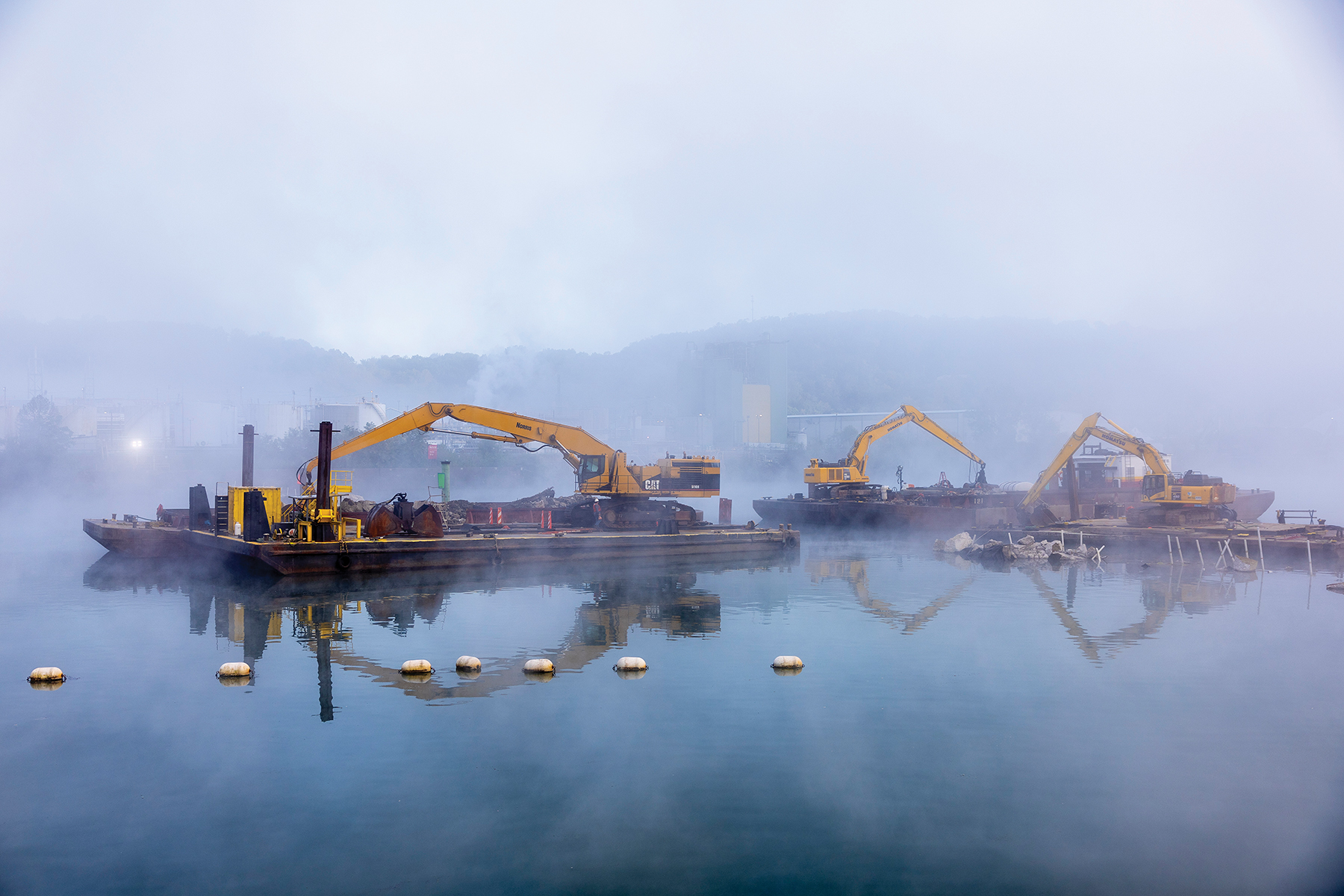Vessel traffic has resumed at the authorized 9-foot depth at the former Monongahela Locks and Dam 3 following the opening of a 100-foot channel on September 5.
Traffic had been restricted to 7 feet through the landside lock at the site near Elizabeth, Pa., since July 15, when it was discovered that a miscalculation in anticipated water depth over the lock sills required the restriction. Traffic moved to the lock chamber after the dam at the site was breached with controlled explosives July 10 as part of a project to create a continuous pool of riverway stretching 30 miles from Charleroi to Braddock, Penn., improving navigation on the Lower Monongahela River.
The 100-foot navigation channel has a 56-foot width restriction and a 9-foot draft restriction and may be used between 7 a.m. and 7:30 p.m. during periods of unrestricted visibility only. Commercial traffic can also still use the lock chamber with the 7-foot draft restriction. Recreational traffic is limited to moving through the lock chamber to avoid disruption to construction work and commercial traffic.
Signs have been posted both upstream and downstream of the lock to guide vessels to the appropriate entrance and exit points.
While a navigational channel through the breached dam had not been anticipated to open until December, the Pittsburgh District quickly formulated a plan to open the channel sooner, working with contractor Joseph B. Fay Company toward a planned August 28 opening.
Col. Nicholas Melin, commander of the Pittsburgh Engineer District, said the goal was to open the 100-foot-wide channel as soon as safe to do so.
“For the last 45 days, the district has had as its No. 1 priority delivering a 100-foot navigational channel through the dam at Elizabeth in order to allow navigation at full depth along the Monongahela River,” he said.
The August 28 date was ambitious and meant to “to drive the organization to look at every possible option to accelerate delivery,” he said.
Ultimately, he said, it took slightly longer to open the channel because of 117-year-old wooden pilings located 10 feet underwater. Those pilings had been driven down to the bedrock to support the weight of the original fixed-crest dam, which has now been removed across its entire 300-foot length. The pilings were supported with wooden cribbing.
Removing the pilings and cribbing took divers using specialized underwater chainsaws to cut through them, Melin said. The divers then guided excavators to scoop out debris 12 feet below the surface of the fast-moving channel.
Afterward, both the contractor and Corps used sonar to ensure no obstacles remained sticking up from the river bottom.
“We conducted multiple surveys to ensure that navigation channel could safely transit fully loaded barges at the proper navigational depth,” Melin said.
He praised the team that worked quickly and efficiently to establish the channel while also maintaining traffic at a 7-foot depth through the lock, preventing shutdowns that would have cost industry time and money.
Crews worked a minimum of 14-hour days six days a week to accelerate the channel opening. During critical phases of the project, they worked two shifts, completing 18 to 20 hours a day of work seven days a week.
“It was a tremendous commitment not only by us within the district but also by our contractor,” Melin said. “We accelerated the opening of the channel by 90 days out of a 180-day period of performance to remove the dam, so if you think about it, we cut the schedule in half to open this 100-foot channel. That, on any construction project, let alone any marine construction project, is a pretty dramatic acceleration.”
Between now and December 4, Melin said the contractor will remove piles of rubble leftover from the dam demolition, getting down to a 13-foot depth across what will become a 300-foot-wide navigational channel.
“In December we’ll have fully removed the dam, and a two-way channel will be fully open to traffic 24 hours a day,” Melin said.
Once the district has completely removed the dam, the river level between the Braddock and John P. Murtha locks and dams will adjust to the new authorized elevation of 723.1 (NAVD 88), approximately one-half to one foot lower than the river level on September 5.
Beginning in 2025, the district will remove the lock chambers and the support buildings on the land, leaving only the land wall of the landside chamber in place.
Melin said he hopes that lessons learned from establishing the 100-foot channel and demolishing the dam will be useful as the Corps works to establish best practices and improve infrastructure on projects throughout the inland waterways system.
“Anytime you work with very old structures, there’s always a bit of variability that is involved,” he said.
As it was the first time a dam has been removed in a navigation channel, resulting in equalization of the upstream and downstream pools, Melin said, “There were a number of firsts that we had to contend with.”
Melin also spoke about the project at Locks and Dam 3 as the final piece of the Lower Monongahela Project, which also involved installation of a new gated dam at Braddock (Locks and Dam 2), replacing the former fixed-crest dam, and a new, expanded riverside lock chamber at Charleroi (Locks and Dam 4), which was renamed in memory of former U.S. Rep. John P. Murtha and dedicated on August 28.
Together, these projects are “going to bring the Monongahela into and through the next century with modern lock infrastructure,” Melin said.
Additionally, he said, they will allow the Corps of Engineers to “fully realize” $200 million in benefits for the region annually.
————
Photo caption: Pittsburgh Engineer District contractors stage several work barges used to demolish and remove rubble from a fixed-crest dam at Monongahela River Locks and Dam 3 in Elizabeth, Pa., on September 5. (Photos by Michel Sauret/Pittsburgh Engineer District)




